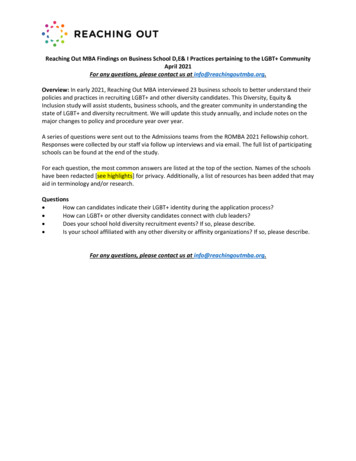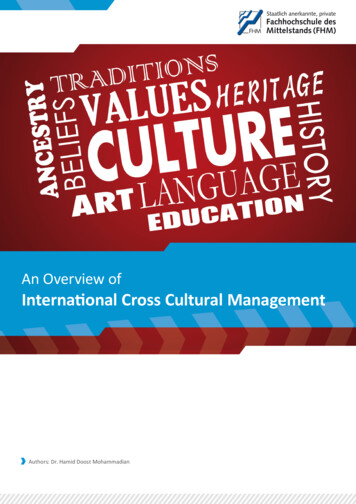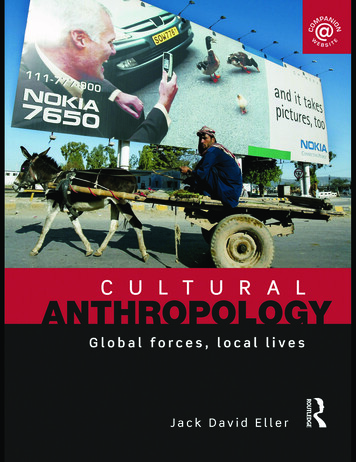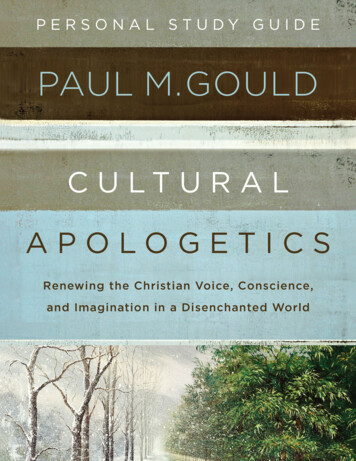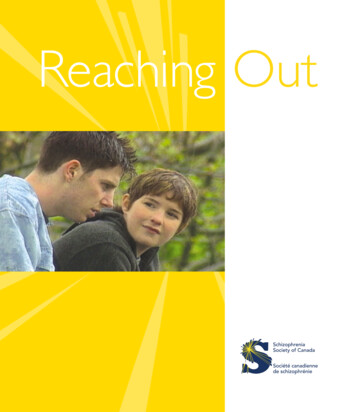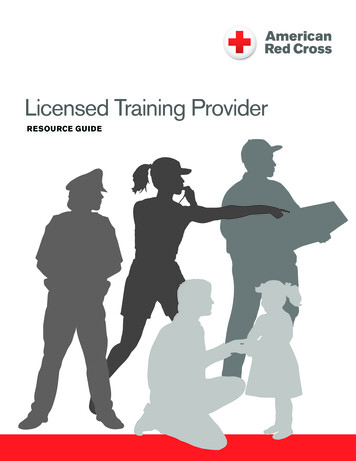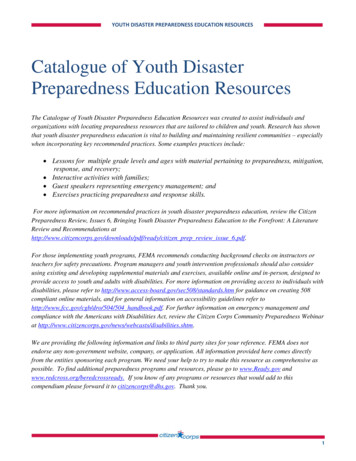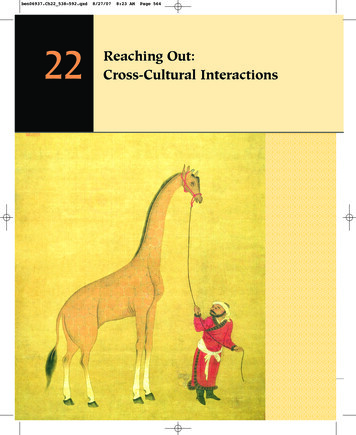
Transcription
ben06937.Ch22 538-592.qxd228/27/078:23 AMPage 564Reaching Out:Cross-Cultural Interactions
ben06937.Ch22 538-592.qxd8/27/078:23 AMPage 565Long-Distance Trade and TravelPatterns of Long-Distance TradePolitical and Diplomatic TravelMissionary CampaignsLong-Distance Travel and Cross-Cultural ExchangesRecovery in Europe: State BuildingRecovery in Europe: The RenaissanceExploration and ColonizationThe Chinese Reconnaissance of the Indian Ocean BasinEuropean Exploration in the Atlantic and Indian OceansCrisis and RecoveryBubonic PlagueRecovery in China: The Ming DynastyOne of the great world travelers of all time was the Moroccan legal scholar Ibn Battuta. Bornin 1304 at Tangier, Ibn Battuta followed family tradition and studied Islamic law. In 1325 heleft Morocco, perhaps for the first time, to make a pilgrimage to Mecca. He traveled by caravan across north Africa and through Egypt, Palestine, and Syria, arriving at Mecca in 1326.After completing his hajj Ibn Battuta did not head for home but spent a year visiting Mesopotamia and Persia, then traveled by ship through the Red Sea and down the east African coastas far south as Kilwa. By 1330 he had returned to Mecca, but he did not stay there long.When he learned that the sultan of Delhi offered handsome rewards to foreign legal scholars, he set off for India. Instead of traveling there directly by sailing across the Arabian Sea,however, he followed a long and circuitous land route that took him through Egypt, Syria,Anatolia, Constantinople, the Black Sea, and the great trading cities of central Asia, Bokharaand Samarkand. Only in 1333 did he arrive in Delhi, from the north.For the next eight years, Ibn Battuta remained in India, serving mostly as a qadi (judge) inthe government of Muhammad ibn Tughluq, the sultan of Delhi. In 1341 Muhammad appointed him to head an enormous embassy to China, but a violent storm destroyed theparty’s ships as they prepared to depart Calicut for the sea voyage to China. All personalgoods and diplomatic presents sank with the ships, and many of the passengers drowned.(Ibn Battuta survived because he was on shore attending Friday prayers at the mosque whenthe storm struck.) For the next several years, Ibn Battuta made his way around southern India,Ceylon, and the Maldive Islands, where he served as a qadi for the recently founded Islamicsultanate, before continuing to China on his own about 1345. He visited the bustling southern Chinese port cities of Quanzhou and Guangzhou, where he found large communities ofMuslim merchants, before returning to Morocco in 1349 by way of southern India, the Persian Gulf, Syria, Egypt, and Mecca.Still, Ibn Battuta’s travels were not complete. In 1350 he made a short trip to the kingdomof Granada in southern Spain, and in 1353 he joined a camel caravan across the Saharadesert to visit the Mali empire, returning to Morocco in 1355. During his travels Ibn Battutavisited the equivalent of forty-four modern countries and logged more than 117,000 kilometers (73,000 miles). His account of his adventures stands with Marco Polo’s book among theclassic works of travel literature.Between 1000 and 1500 C.E., the peoples of the eastern hemisphere traveled, traded,communicated, and interacted more regularly and intensively than ever before. The largeempires of the Mongols and other nomadic peoples provided a political foundation for thisOPPOSITE:A giraffe from east Africa sent as a present to China in 1414 and paintedby a Chinese artist at the Ming zoo.565
ben06937.Ch22 538-592.qxd566PART IV 8/27/078:23 AMPage 566An Age of Cross-Cultural Interaction, 1000 to 1500 C.E.cross-cultural interaction. When they conquered and pacified vast regions, nomadic peoplesprovided safe roads for merchants, diplomats, missionaries, and other travelers. Quite apartfrom the nomadic empires, improvements in maritime technology led to increased traffic inthe sea-lanes of the Indian Ocean and the South China Sea. As a result, long-distance travelbecame much more common than in earlier eras, and individual travelers such as Ibn Battutaand Marco Polo sometimes ventured throughout much of the eastern hemisphere.Merchants and travelers exchanged more than trade goods. They diffused technologiesand spread religious faiths. They also exchanged diseases and facilitated the spread ofpathogens that caused widespread and deadly epidemics. During the middle decades of thefourteenth century, bubonic plague traveled the trade routes from western China to centralAsia, southwest Asia, north Africa, and Europe. During its initial, furious onslaught, bubonicplague ravaged societies wherever it struck, and it continued to cause epidemics for threecenturies and more.Gradually, however, societies recovered from the plague. By the early fifteenth century,Chinese and western European peoples in particular had restabilized their societies andbegun to renew cross-cultural contacts. In Europe, that effort had profound consequences formodern world history. As they sought entry to the markets of Asia, European mariners notonly established direct connections with African and Asian peoples but also sailed to thewestern hemisphere and the Pacific Ocean. Their voyages brought the peoples of the easternhemisphere, the western hemisphere, and Oceania into permanent and sustained interaction. Thus cross-cultural interactions of the period 1000 to 1500 pointed toward global interdependence, a principal characteristic of modern world history.Long-Distance Trade and TravelTravelers embarked on long-distance journeys for a variety of reasons. Nomadic peoplesranged widely in the course of migrations and campaigns of conquest. East Europeanand African slaves traveled involuntarily to the Mediterranean basin, southwest Asia,India, and sometimes even southern China. Buddhist, Christian, and Muslim pilgrimsundertook extraordinary journeys to visit holy shrines. Three of the more importantmotives for long-distance travel between 1000 and 1500 C.E. were trade, diplomacy,and missionary activity. The cross-cultural interactions that resulted helped spread technological innovations throughout the eastern hemisphere.Patterns of Long-Distance TradeTrading CitiesMerchants engaged in long-distance trade relied on two principal networks of traderoutes. Luxury goods of high value relative to their weight, such as silk textiles andprecious stones, often traveled overland on the silk roads used since classical times.Bulkier commodities, such as steel, stone, coral, and building materials, traveled thesea-lanes of the Indian Ocean, since it would have been unprofitable to transport themoverland. The silk roads linked all of the Eurasian landmass, and trans-Saharan caravanroutes drew west Africa into the larger economy of the eastern hemisphere. The sealanes of the Indian Ocean served ports in southeast Asia, India, Arabia, and east Africawhile also offering access via the South China Sea to ports in China, Japan, Korea, andthe spice-bearing islands of southeast Asia. Thus, in combination, land and sea routestouched almost every corner of the eastern hemisphere.As the volume of trade increased, the major trading cities and ports grew rapidly,attracting buyers, sellers, brokers, and bankers from parts near and far. Khanbaliq(modern Beijing), Hangzhou, Quanzhou, Melaka, Cambay, Samarkand, Hormuz,
ben06937.Ch22 538-592.qxd8/27/078:23 AMPage 567CHAPTER 22 Reaching Out: Cross-Cultural Interactions567The massive walls ofthis caravanserai inCairo protectedtravelers and theirgoods, while food,drink, and lodgingwere available insidefor merchants as wellas their animals.Baghdad, Caffa, Cairo, Alexandria, Kilwa, Constantinople, Venice, Timbuktu, andmany other cities had large quarters occupied by communities of foreign merchants.When a trading or port city enjoyed a strategic location, maintained good order, andresisted the temptation to levy excessive customs fees, it had the potential to becomea major emporium serving long-distance trade networks. A case in point is Melaka(in modern Malaysia). Founded in the 1390s, within a few decades Melaka becamethe principal clearinghouse of trade in the eastern Indian Ocean. The city’s authorities policed the strategic Strait of Melaka and maintained a safe market that welcomed all merchants and levied reasonable fees on goods exchanged there. By theend of the fifteenth century, Melaka had a population of some fifty thousand people,and in the early sixteenth century the Portuguese merchant Tomé Pires reportedthat more than eighty languages could be heard in the city’s streets.During the early and middle decades of the thirteenth century, the Mongols’campaigns caused economic disruption throughout much of Eurasia—particularly inChina and southwest Asia, where Mongol forces toppled the Song and Abbasid dynasties. Mongol conquests inaugurated a long period of economic decline in southwest Asia where the conquerors destroyed cities and allowed irrigation systems to fallinto disrepair. As the Mongols consolidated their hold on conquered lands, however,they laid the political foundation for a surge in long-distance trade along the silkroads. Merchants traveling the silk roads faced less risk of banditry or political turbulence than in previous times. Meanwhile, strong economies in China, India, andwestern Europe fueled demand for foreign commodities. Many merchants traveledthe whole distance from Europe to China in pursuit of profit.The best-known long-distance traveler of Mongol times was the Venetian MarcoPolo (1253–1324). Marco’s father, Niccolò, and uncle Maffeo were among the firstEuropean merchants to visit China. Between 1260 and 1269 they traveled and tradedthroughout Mongol lands, and they met Khubilai Khan as he was consolidating hishold on China. When they returned to China in 1271, seventeen-year-old MarcoPolo accompanied them. The great khan took a special liking to Marco, who was amarvelous conversationalist and storyteller. Khubilai allowed Marco to pursue hismercantile interests in China and also sent him on numerous diplomatic missions,partly because Marco regaled him with stories about the distant parts of his realm.After seventeen years in China, the Polos decided to return to Venice, and KhubilaiMarco Polo
ben06937.Ch22 538-592.qxd568PART IV 8/27/078:23 AMPage 568An Age of Cross-Cultural Interaction, 1000 to 1500 C.E.Map 22.1 Travels ofMarco Polo and IbnBattuta. Compare the routestaken by Marco Polo and IbnBattuta during their travels.How did the two men choosewhere to travel? What conditions made it possible for themto travel so far from theirhomes?MoscowVeniceBlack SeaAral Seas p iaConstantinopleCaEUROPEGenoan Se aMedFeziterraBaghdadnean SeaJerusalemCairoSirafPersian GulfMedinaS A H A R AMeccaR edA F R I C asaAT L A N T I COCEANKilwaMADAGASCARgranted them permission to leave. They went back on the sea route by way of Sumatra, Ceylon, India, and Arabia, arriving in Venice in 1295.A historical accident has preserved the story of Marco Polo’s travels. After his return from China, Marco was captured and made a prisoner of war during a conflictbetween his native Venice and its commercial rival, Genoa. While imprisoned, Marcorelated tales of his travels to his fellow prisoners. One of them was a writer of romances, and he compiled the stories into a large volume that circulated rapidlythroughout Europe.In spite of occasional exaggerations and tall tales, Marco’s stories deeply influenced European readers. Marco always mentioned the textiles, spices, gems, andother goods he observed during his travels, and European merchants took note,eager to participate in the lucrative trade networks of Eurasia. The Polos were among
ben06937.Ch22 538-592.qxd8/27/078:23 AMPage 569Reaching Out: Cross-Cultural InteractionsCHAPTER 22 He)Ya nHuYe l low(gzihang NDIABa y o fBenga lMALDIVE IS.Sea ofJap anKhanbaliqangKarakorumYellowSeaEastCh inaSe aPA C I F I COCEANSo ut hCh inaSe aCEYLONMelakaSUMATRAJAVAINDIAN OCEANMongol empiresMarco Polo’s travelsIbn Battuta’s travelsthe first Europeans to visit China, but they were not the last. In their wake camehundreds of others, mostly Italians. In most cases their stories do not survive, buttheir travels helped to increase European participation in the larger economy of theeastern hemisphere.Political and Diplomatic TravelMarco Polo came from a family of merchants, and merchants were among the most avidreaders of his stories. Marco himself most likely collaborated closely with Italian merchants during his years in China. Yet his experiences also throw light on long-distancetravel undertaken for political and diplomatic purposes. Khubilai Khan and the otherMongol rulers of China did not entirely trust their Chinese subjects and regularly569
ben06937.Ch22 538-592.qxd570PART IV 8/27/078:23 AMPage 570An Age of Cross-Cultural Interaction, 1000 to 1500 C.E.An illustration from afourteenth-centuryFrench manuscriptdepicts Marco Polopicking pepper withlocal workers insouthern India.Mongol-ChristianDiplomacyRabban Saumaappointed foreigners to administrative posts. In his account of his travels, Marco reportedthat Khubilai appointed him governor of the large trading city of Yangzhou. There is noindependent evidence to confirm that claim, but Marco may well have filled some sort ofadministrative position. In addition, he represented Khubilai Khan’s interests on diplomatic missions. To support himself in China, then, Marco supplemented his mercantileventures with various official duties assigned to him by his patron, the great khan.The emergence of elaborate trading networks and the establishment of vast imperial states created great demand for political and diplomatic representation during thecenturies after 1000 C.E. The thirteenth century was a time of especially active diplomacy involving parties as distant as the Mongols and western Europeans, both ofwhom considered a military alliance against their common Muslim foes. As EuropeanChristians sought to revive the crusading movement and recapture Jerusalem fromMuslim forces, the Mongols were attacking the Abbasid empire from the east. Duringthe 1240s and 1250s, Pope Innocent IV dispatched a series of envoys who invited theMongol khans to convert to Christianity and join Europeans in an alliance against theMuslims. The khans declined the invitation, proposing in reply that the pope and European Christians submit to Mongol rule or face destruction.Although the early round of Mongol-European diplomacy offered little promise ofcooperation, the Mongols later initiated another effort. In 1287 the Mongol ilkhan ofPersia planned to invade the Muslim-held lands of southwest Asia, capture Jerusalem,and crush Islam as a political force in the region. In hopes of attracting support for theproject, he dispatched Rabban Sauma, a Nestorian Christian priest born in the Mongolcapital of Khanbaliq but of Turkish ancestry, as an envoy to the pope and Europeanpolitical leaders.Rabban Sauma met with the kings of France and England, the pope, and other highofficials of the Roman Catholic church. He enjoyed a fine reception, but he did not succeed in attracting European support for the ilkhan. Only a few years later, in 1295,Ghazan, the new ilkhan of Persia, converted to Islam, thus precluding any further possibility of an alliance between the Mongols of Persia and European Christians. Nevertheless, the flurry of diplomatic activity illustrates the complexity of political affairs in theeastern hemisphere and the need for diplomatic consultation over long distances.
ben06937.Ch22 538-592.qxd8/27/078:23 AMPage 571CHAPTER 22 Reaching Out: Cross-Cultural InteractionsThe expansion of Islamic influence in the eastern hemisphere encouraged a different kind of politically motivated travel. Legal scholars and judges played a crucialrole in Islamic societies, since the sharia prescribed religious observances and socialrelationships based on the Quran. Conversions to Islam and the establishment of Islamic states in India, southeast Asia, and sub-Saharan Africa created a demand forMuslims educated in Islamic law. After about the eleventh century, educated Muslims from southwest Asia and north Africa regularly traveled to recently convertedlands to help instill Islamic values.Best known of the Muslim travelers was Ibn Battuta (1304–1369). Islamic rulersgoverned most of the lands Ibn Battuta visited—including India, the Maldive Islands, the Swahili city-states of east Africa, and the Mali empire—but very few Muslims educated in the law were available in those lands. With his legal credentials IbnBattuta had little difficulty finding government positions. As qadi and advisor to thesultan of Delhi, he supervised the affairs of a wealthy mosque and heard cases at law,which he strictly enforced according to Islamic standards of justice. On one occasionIbn Buttuta sentenced a man to receive eighty lashes because he had drunk wineeight years earlier.After leaving northern India, Ibn Battuta obtained a post as qadi in the MaldiveIslands. There he heard cases at law and worked zealously to promote proper observance of Islam. He ordered lashings for men who did not attend Friday prayers, andhe once sentenced a thief to lose his right hand in accordance with punishment prescribed by the sharia. He also attempted, unsuccessfully, to persuade island womento meet the standards of modesty observed in other Islamic lands by covering theirbreasts. In both east and west Africa, Ibn Battuta consulted with Muslim rulers andoffered advice about government, women’s dress, and proper relationships betweenthe sexes. Like many legal scholars whose stories went unrecorded, Ibn Battuta provided guidance in the ways of Islam in societies recently converted to the faith.Ibn BattutaMissionary CampaignsIslamic values spread not only through the efforts of legal scholars but also throughthe missionary activities of Sufi mystics. As in the early days of Islam, Sufis in the period from 1000 to 1500 ventured to recently conquered or converted lands andsought to win a popular following for the faith in India, southeast Asia, and subSaharan Africa. Sufis did not insist on a strict, doctrinally correct understanding ofIslam but, rather, emphasized piety and devotion to Allah. They even tolerated continuing reverence of traditional deities, whom the Sufis treated as manifestations ofAllah and his powers. By taking a flexible approach to their missions, the Sufis spreadIslamic values without facing the resistance that unyielding and doctrinaire campaigns would likely have provoked.Meanwhile, Roman Catholic missionaries also traveled long distances, in the interests of spreading Christianity. Missionaries accompanied the crusaders and other forcesto all the lands where Europeans extended their influence after the year 1000. In landswhere European conquerors maintained a long-term presence—such as the Baltic lands,the Balkan region, Sicily, and Spain—missionaries attracted converts in large numbers,and Roman Catholic Christianity became securely established. In the eastern Mediterranean region, however, where crusaders were unable to hold their conquests permanently, Christianity remained a minority faith.The most ambitious missions sought to convert Mongols and Chinese to RomanCatholic Christianity. Until the arrival of European merchants and diplomats in the thirteenth century, probably no Roman Catholic Christian had ever ventured as far east asChina, although Nestorian Christians from central Asia had maintained communitiesSufi MissionariesChristianMissionaries571
ben06937.Ch22 538-592.qxd572PART IV 8/27/078:23 AMPage 572An Age of Cross-Cultural Interaction, 1000 to 1500 C.E.Sources from the PastIbn Battuta on Customs in the Mali EmpireLong-distance travelers often encountered unfamiliar customs in foreign societies. The Moroccan traveler Ibn Battutaapproved heartily when staying with hosts who honored the values of his own Muslim society, but he had little tolerancefor those who did not. Here he describes what he witnessed at the sultan’s court in the Mali empire.The Blacks are the most respectful of people to theirking and abase themselves most before him. They swearby him, saying Mansa Sulaiman ki [the law of MansaSulaiman, the Mali sultan]. If he summons one of themat his session in the cupola . . . the man summoned removes his robe and puts on a shabby one, takes off histurban, puts on a dirty skull-cap and goes in with hisrobe and his trousers lifted half way to his knees. Hecomes forward humbly and abjectly, and strikes theground hard with his elbows. He stands as if he wereprostrating himself in prayer, and hears what the Sultansays like this. If one of them speaks to the Sultan and heanswers him, he takes his robe off his back, and throwsdust on his head and back like someone making his ablutions with water. I was astonished that they did not blindthemselves.When the Sultan makes a speech in his audiencethose present take off their turbans from their heads andlisten in silence. Sometimes one of them stands beforehim, recounts what he has done for his service, and says:“On such and such a day I did such and such, and Ikilled so and so on such and such a day.” Those whoknow vouch for the truth of that and he does it in thisway. One of them draws the string of his bow, then letsit go as he would do if he were shooting. If the Sultansays to him: “You are right” or thanks him, he takes offhis robe and pours dust on himself. That is good manners among them. . . .Among their good practices are their avoidance ofinjustice; there is no people more averse to it, and theirSultan does not allow anyone to practice it in any measure; [other good practices include] the universal security in their country, for neither the traveller nor theresident there has to fear thieves or bandits . . . theirpunctiliousness in praying, their perseverance in joiningthe congregation, and in compelling their children todo so; if a man does not come early to the mosque hewill not find a place to pray because of the dense crowd;it is customary for each man to send his servant with hisprayer-mat to spread it out in a place reserved for himuntil he goes to the mosque himself. . . . They dress inclean white clothes on Fridays; if one of them has only athreadbare shirt he washes it and cleans it and wears itfor prayer on Friday. They pay great attention to memorizing the Holy Qur’an. . . .Among their bad practices are that the women servants, slave-girls and young daughters appear naked before people, exposing their genitals. I used to see manylike this in [the fasting month of] Ramadan, for it is customary for the fararis [commanders] to break the fast inthe Sultan’s palace, where their food is brought to themby twenty or more slave-girls, who are naked. Womenwho come before the Sultan are naked and unveiled, andso are his daughters. On the night of the twenty-seventhof Ramadan I have seen about a hundred naked slavegirls come out of his palace with food; with them weretwo daughters of the Sultan with full breasts and they toohad no veil. They put dust and ashes on their heads as amatter of good manners. [Another bad practice:] Manyof them eat carrion, dogs and donkeys.FOR FURTHER REFLECTIONDiscuss the various ways in which Islamic influencesand established local customs came together in theMali empire.SOURCE: H. A. R. Gibb, trans. The Travels of Ibn Battuta, A.D. 1325–1354, 4 vols. London: Hakluyt Society,1958–94, 4:960, 965–66.there since the seventh century. As more Europeans traveled to China, their expatriatecommunities created a demand for Roman Catholic services. Many of the RomanCatholic priests who traveled to China probably intended to serve the needs of thosecommunities, but some of them also sought to attract converts.
ben06937.Ch22 538-592.qxd8/27/078:23 AMPage 573CHAPTER 22 Reaching Out: Cross-Cultural InteractionsMost active of the Roman Catholicmissionaries in China was John of Montecorvino, an Italian Franciscan who wentto China in 1291, became the first archbishop of Khanbaliq in 1307, and diedthere in 1328. While serving the community of Roman Catholic expatriates inChina, John worked energetically to establish Christianity in the host society. Hetranslated the New Testament and thebook of Psalms into Turkish, a languagecommonly used at the Mongol court, andhe built several churches in China. Hetook in young boys from Mongol andChinese families, baptized them, andtaught them Latin and Roman Catholicrituals. He claimed to have baptized sixthousand individuals by 1305, and he invited the great khan himself to convert toCaterina Vilioni, daughter of the VenetianChristianity. Although popular and widelymerchant Domenico Vilioni, died in therespected among Europeans, Chinese, andChinese trading city of Yangzhou in 1342.Mongols alike, John attracted few AsianHer tombstone, which shows she waspeoples to Christianity.part of the Roman Catholic communityRoman Catholic authorities in Europein Yangzhou, came to light during a construction project in 1951.dispatched many other priests and missionaries to China during the early fourteenth century, but like John of Montecorvino, they won few converts. Missionssuccessfully established Christian communities in Scandinavia, eastern Europe, Spain,and the Mediterranean islands that European armies recaptured from Muslims duringthe centuries after 1000 C.E., but east Asia was too distant for the resources available tothe Roman Catholic church. Moreover, east Asian peoples already possessed sophisticated religious and cultural traditions, so Christianity had little appeal. Nevertheless,Christian missions to China continued until the mid-fourteenth century, when the collapse of the Mongols’ Yuan dynasty and the eruption of epidemic disease temporarilydisrupted long-distance travel across Eurasia.573John of MontecorvinoLong-Distance Travel and Cross-Cultural ExchangesLong-distance travel of all kinds, whether for commercial, political, diplomatic, or missionary purposes, encouraged cultural exchanges between peoples of different societies. Songs, stories, religious ideas, philosophical views, and scientific knowledge allpassed readily among travelers who ventured into the larger world during the era from1000 to 1500 C.E. The troubadours of western Europe, for example, drew on the poetry, music, and love songs of Muslim performers when developing the literature ofcourtly love. Similarly, European scientists avidly consulted their Muslim and Jewishcounterparts in Sicily and Spain to learn about their understanding of the natural world.Large numbers of travelers also facilitated agricultural and technological diffusionduring the period from 1000 to 1500. Indeed, technological diffusion sometimes facilitated long-distance travel. The magnetic compass, for example, invented in Chinaduring the Tang or the Song dynasty, spread throughout the Indian Ocean basin during the eleventh century, and by the mid-twelfth century European mariners usedCultural Exchanges
ben06937.Ch22 538-592.qxd574PART IV 8/27/078:23 AMPage 574An Age of Cross-Cultural Interaction, 1000 to 1500 C.E.Sources from the PastJohn of Montecorvino on His Mission in ChinaThe Franciscan John of Montecorvino (1247–1328) served as a Roman Catholic missionary in Armenia, Persia, andIndia before going to China in 1291. There he served as priest to expatriate European Christians, and he sought toattract converts to Christianity from the Mongol and Chinese communities. In a letter of 8 January 1305 asking forsupport from his fellow Franciscans in Italy, John outlined some of his activities during the previous thirteen years.[After spending thirteen months in India] I proceededon my further journey and made my way to China, therealm of the emperor of the Mongols who is calledthe great khan. To him I presented the letter of our lordthe pope and invited him to adopt the Catholic faith ofour Lord Jesus Christ, but he had grown too old in idolatry. However, he bestows many kindnesses upon theChristians, and these two years past I have gotten alongwell with him. . . .I have built a church in the city of Khanbaliq, inwhich the king has his chief residence. This I completedsix years ago; and I have built a bell tower to it and putthree bells in it. I have baptized there, as well as I canestimate, up to this time some 6,000 persons. . . . And Iam often still engaged in baptizing.Also I have gradually bought one hundred and fiftyboys, the children of pagan parents and of ages varyingfrom seven to eleven, who had never learned any religion. These boys I have baptized, and I have taughtthem Greek and Latin after our manner. Also I havewritten out Psalters for them, with thirty hymnals andbreviaries [prayer books]. By help of these, eleven of theboys already know our service and form a choir and taketheir weekly turn of duty as they do in convents, whetherI am there or not. Many of the boys are also employedin writing out Psalters and other suitable things. HisMajesty the Emperor moreover delights much to hearthem chanting. I have the bells rung at all the canonicalhours, and with my congregation of babes and sucklingsI perform divine service, and the chanting we do by earbecause I have no service book with the notes. . . .Indeed if I had but two or three comrades to aid me,it is possible that the emperor khan himself would havebeen baptized by this time! I ask then for such brethrento come, if any are willing to come, such I mean as willmake it their great business to lead exemplary lives. . . .I have myself grown old and grey, more with toiland trouble than with years, for I am not more thanfifty-eight. I have got a competent knowledge of the language and script which is most generally used by theTartars. And I have already translated into that languageand script the Ne
(Ibn Battuta survived because he was on shore attending Friday prayers at the mosque when the storm struck.) For the next several years, Ibn Battuta made his way around southern India, Ceylon, and the Maldive Islands, where he served as a qadi for the recently founded Islamic sul
